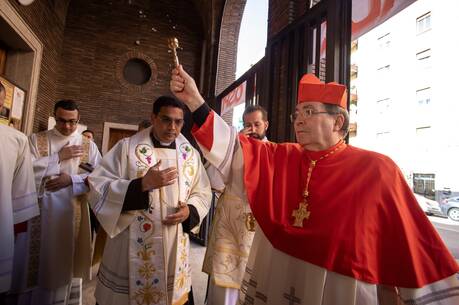The intractable question of allowing affirmative action to be used in the selection of students for college admission will finally be settled by the United States Supreme Court. Two cases involving plaintiffs denied admission at the University of Michigan, allegedly because they are white, will be decided by the High Court before the end of June 2003.
The Supreme Court has not ruled directly on this issue since the Baake decision in 1968. In that decision the court invalidated an arrangement at the University of California because, the court found, it involved quotas. But in a famous concurring view by Justice Lewis Powell, it allowed colleges to pursue a policy of affirmative action in order to guarantee diversity in the university community.
Before analyzing the clashing views on this tormenting question, I feel I should reveal my bias. The Georgetown University Law Center, a Catholic and Jesuit institution established in 1870, refused to accept any black Americans until 1953. Georgetown looked upon itself as a southern university and, like Duke, Vanderbilt and Tulane, admitted only whites. Indeed, there were no southern colleges or universities, public or private, that admitted black students. During the years from the Emancipation Proclamation to 1954, more than 100 all-black colleges were established.
Discrimination based on race alone was outlawed in 1954 in Brown v. Board of Education. Shortly afterward, the Georgetown University Law Center adopted a vigorous program to make restitution for its near century of denying entry to nonwhites. Some 12 percent of its student population are now black—the same percentage as in the nation as a whole. As a result, Georgetown produces some 55 black American lawyers each year, the largest of any law school in the nation except traditionally black Howard University in Washington, D.C.
It is not entirely clear what would happen to this program if the Supreme Court ruled that race could not be used in assessing the qualifications of candidates. But it is beyond doubt that, despite some questions by white students theoretically denied admission, the program has been immensely successful. A widespread uneasiness remains, however, that most universities take race into account and thus make race a factor that has helped some and, at least theoretically, hurt others. Public opinion is still deeply divided on the referendum in Proposition 209, by which the voters of California voted narrowly that race cannot be used for or against applicants to the University of California. Cardinal Roger Mahony of Los Angeles issued a strong statement urging the people of California to vote against that proposition. Similarly, religious and civic leaders and officials of higher education claimed that Proposition 209 would be bad for society. Cardinal Mahony based his opposition to the proposition on the National Conference of Catholic Bishops’ letter on the economy, Economic Justice for All (1986), which stated: “Where the effects of past discrimination persist, society has the obligation to take positive steps to overcome the legacy of injustice.”
Countless articles and books have been written since the 1978 Bakke decision. The Supreme Court has made it clear that even a “benign” preference based on race must be evaluated under the “strict scrutiny” test, the most exacting in the law.
It is possible that the best study of affirmative action is a book written by Derek Bok, former president of Harvard University, and William G. Bowen, former president of Princeton University. In The Shape of the River: Long-Term Consequences Considering Race in College and University Admissions (Princeton, 1998), one finds a vast array of information about the use of race-sensitive admissions at the college level. The book also points out that colleges have always used factors beyond scores and grades; they give preference to the children of alumni, tuba players, star athletes and students from schools where the college desires to be better known. Derek Bok has recently endorsed the race-sensitive program at the University of Michigan.
The University of Michigan has broad support for its program of including diversity as one of the goals of its educational philosophy. The American Medical Association and the American Bar Association have in briefs endorsed Michigan’s program. The American Jewish Committee, which opposed the University of California in the Bakke decision in 1968, has also now endorsed the Michigan program. But the Anti-Defamation League of the American Jewish Congress has decided to oppose the program at the Michigan Law School. The A.J.C. considers any use of race in admissions to be unconstitutional.
Underlying the struggle over the Michigan program is the status of de facto segregation in American life. The latest study by Professor Gary Orfield of Harvard University shows that in 1999, 70 percent of black children attended predominantly minority schools—up from 66 percent in 1992 and 63 percent in 1981. The most segregated schools are in the states of New York, Michigan, Illinois and California.
Many applicants to college did not attend schools that are racially balanced. Both white and black colleges need the experience of a diverse enrollment. That is the primary reason why the University of Michigan and the vast majority of colleges have made the attainment of diversity an essential goal of their educational philosophy. In a Gallup poll, 80 percent of white students feel that diversity has helped them and that existing race-conscious admissions policies should be retained or strengthened.
It seems clearly predictable that the Supreme Court will divide 5 to 4 on the policy followed by the University of Michigan. Much has happened since the ruling in Bakke in 1968, but blacks are still underrepresented in the legal profession. They constitute only 3.2 percent of it, although they represent over 12 percent of the total population.
In 1968 the federal government began a modestly funded program to help members of minorities get into law school. I participated in that program, which offered remedial and compensatory training for African American students with a view toward helping them to be admitted. At an airport recently, an African American man spoke to me about his participation in that same program for prospective law students at Boston College Law School, where I was dean. He recalled attending a cookout one evening in July of the awful year 1968, the year when Martin Luther King Jr. and Robert F. Kennedy were assassinated. He spoke gratefully about the program and of his conversations with me at that time. He also shared with me some good news: he had recently been appointed as the first black lawyer to be a member of the Supreme Court of Georgia. To my surprise, I cried. All of the struggles of the 1960’s to encourage minorities to move into the legal profession had paid off.
It is to be feared that the forthcoming decision of the United States Supreme Court could nullify the fruits of those struggles. The court could confuse, delay or destroy some of the most creative and constructive plans of the nation’s best universities to bring justice and real equality to every eighth American—those of African ancestry.








Editor's note: We have corrected the date in the Web version, but it is Bakke not Baake.
· Restitution is ‘The act of restoring to the rightful owner something that has been taken away’. So, for all those black applicants who have been turned away from Georgetown because of their color – let Georgetown change its policy and admit them now. · There is no value in general population statistics in devising quotas (and that’s the word – why beat around the bush) for any specific group. What may be relevant is the population of those qualified. · Representation is not the same as identity. You don’t have to be black to represent blacks or white to represent whites. · There is nothing directly valuable about diversity. If there were, why limit it to race? Why not size, politics, religion, or gender identification. The fact is that ‘diversity’ is a spin on ‘divisiveness’, and that’s exactly what we have when we give special rights to groups.
Attempts to right the wrongs of the past in higher education are never going to make any sense. What’s needed is some solution to our problems in primary and secondary education so that anyone with ability can become qualified. And those problems cross racial divides.
Editor's note: We have corrected the date in the Web version, but it is Bakke not Baake.
· Restitution is ‘The act of restoring to the rightful owner something that has been taken away’. So, for all those black applicants who have been turned away from Georgetown because of their color – let Georgetown change its policy and admit them now. · There is no value in general population statistics in devising quotas (and that’s the word – why beat around the bush) for any specific group. What may be relevant is the population of those qualified. · Representation is not the same as identity. You don’t have to be black to represent blacks or white to represent whites. · There is nothing directly valuable about diversity. If there were, why limit it to race? Why not size, politics, religion, or gender identification. The fact is that ‘diversity’ is a spin on ‘divisiveness’, and that’s exactly what we have when we give special rights to groups.
Attempts to right the wrongs of the past in higher education are never going to make any sense. What’s needed is some solution to our problems in primary and secondary education so that anyone with ability can become qualified. And those problems cross racial divides.